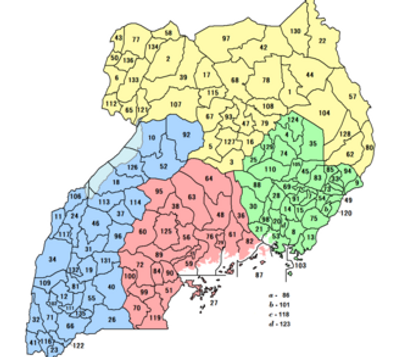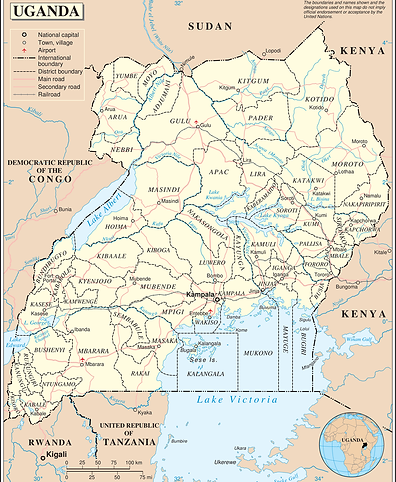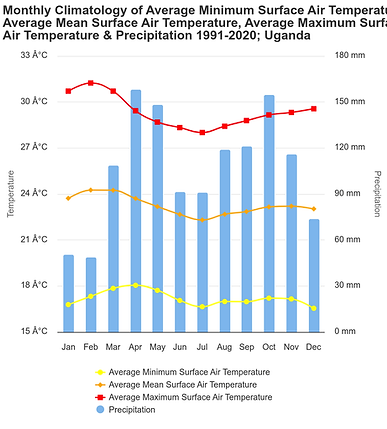
RESUME HISTORIQUE
Le pays a toujours été majoritairement monarchique. Ses nombreuses sous-régions étaient divisées en royaumes, avec à leur tête des chefs cumulant les fonctions politiques et culturelles. L'histoire du pays a été façonnée par la diversité de ses groupes ethniques et de ses cultures.
L'Ouganda précolonial : Avant la colonisation européenne, l'Ouganda abritait divers royaumes et groupes ethniques. Le royaume du Buganda était particulièrement influent. À partir de 1886, une série de guerres de religion eut lieu au Buganda. Les intérêts commerciaux britanniques souhaitant ardemment protéger la route commerciale du Nil, le gouvernement britannique fut incité à annexer le Buganda et les territoires adjacents pour créer le protectorat de l'Ouganda en 1894.
Protectorat de l'Ouganda (1894-1962) : Les Britanniques introduisirent de nouveaux systèmes d'administration et de développement économique.
Indépendance (1962 à 1965) : L'Ouganda obtint son indépendance de la Grande-Bretagne le 9 octobre 1962. Milton Obote devint le premier Premier ministre.
Instabilité politique (1962-1966) : Les années qui suivirent l'indépendance furent marquées par l'instabilité politique, des coups d'État et des guerres civiles. En 1966, à la suite d'une lutte de pouvoir, Obote suspendit la constitution et destitua le président et le vice-président, dont les fonctions étaient alors honorifiques. En 1967, une nouvelle constitution proclama l'Ouganda république et abolit les royaumes traditionnels. Obote fut proclamé président.
Régime d'Amin (1971-1979) : En 1971, le général Idi Amin Dada prit le pouvoir par un coup d'État militaire. Sa dictature brutale entraîna la mort de centaines de milliers d'Ougandais. Le règne d'Amin prit fin après la guerre Ouganda-Tanzanie en 1979, au cours de laquelle les forces tanzaniennes, aidées par des exilés ougandais, envahirent l'Ouganda.
Ère post-Amin (1979-présent) : Après le renversement d'Amin en 1979, l'Ouganda connut une période de reconstruction et tenta un retour à un régime démocratique. Dans les années 1980, le pays fut ravagé par des guérillas alors que différents gouvernements se succédaient au pouvoir pour être rapidement renversés. Le président Yoweri Museveni dirige le pays depuis 1986 et a été réélu lors des dernières élections présidentielles de janvier 2021. Ces dernières années, la paix a été pleinement rétablie dans le pays. L'Ouganda a réalisé des progrès significatifs en matière de croissance et de développement économiques.
Gouvernement et politique actuels
L'Ouganda est une république présidentielle unitaire à régime autoritaire dominé par un parti unique.
• Président : Yoweri Museveni
• Vice Président : Jessica Alupo
• Premier Ministre : Robinah Nabbanja
L'Ouganda est membre de la Communauté d'Afrique de l'Est (CAE), aux côtés du Kenya, de la Tanzanie, du Rwanda, du Burundi et du Soudan du Sud.
En 2022, l'Ouganda est divisé en quatre régions et 136 districts.
Parallèlement à l'administration de l'État, cinq royaumes bantous traditionnels subsistent, jouissant d'une certaine autonomie, principalement culturelle. Ces royaumes sont le Toro, le Busoga, le Bunyoro, le Buganda et le Rwenzururu.


In 1996, Museveni was sworn as Uganda's first elected president (source : New vision).





GEOGRAPHIE
La Perle de l'Afrique
République d'Ouganda
Capitale : Kampala (a historical name that refers to “where the king goes hunting”)
Total area : 241,038 km² (93,065 sq mi)
Water area : 15,39%
Average altitude : 900 m (2953 feet) above sea level
Highest peak : 5091 m or 16703 feet (Alexandra peak in The Rwenzori Mountains National Park in the South-Wet of Uganda)
It is located in Sub-Saharan Africa, on the East African Plateau – zone of the East African Rift.
The country is neighboured by Kenya (East), Democratic Republic of Congo (West), Tanzania (South), Rwanda (South West) and Sudan (North).
The country is part of the African Great Lakes region and is one of the seven African countries split by the Equator into the Northern and Southern hemispheres.
Its geography is very diverse, consisting of volcanic hills, mountains, and lakes. This variety makes Uganda the Pearl of Africa :
“The kingdom of Uganda is a fairy-tale. You climb up … and at the end there is a wonderful new world. The scenery is different, the vegetation is different, the climate is different, and, most of all, the people are different from anything elsewhere to be seen in the whole range of Africa. For magnificence, for variety of form and colour, for profusion of brilliant life – bird, insect, reptile, beast – for vast scale — Uganda is truly the pearl of Africa.”
W. CHURCHILL, My African Journey.
Uganda is characterized by an important part of inland water. Bounded by Mountains (Rwenzori 5109m, Mount Elgond 4321m, Mgahinga 4127m) and freshwater water bodies, the country shares an important part of the Lake Victoria with Kenya and Tanzania.
The South-East part of the country is mainly covered by the Lake which influences the climate and the local livelihood. The city of Jinja (80km East Kampala) is known as the Source of the Nile since the declaration of the explorer JH Speke (1863). From Jinja, the River Nile flows successively through Lake Kyoga, Murchison Falls and Lake Albert making the Nile basin an important part of Uganda. Other lakes such as Lake Edouard and Lake Bunyonyi complete the long list of natural and protected area to explore.
The climate is largely tropical with two rainy seasons per year, March to May and September to December.
The northern region, which forms one quarter of the country lies outside the tropical belt, and hence experiences only one rainy season, March to October.
Temperatures may vary significantly during day and night from a season to another but also from a region to another during the same season. Uganda experiences moderate temperatures throughout the year, around 22.8°C, with monthly temperatures ranging between 21.7°C (July) and 23.9°C (February).
From western high top mountains with snow and frequent rains to the North semi-arid in nature, Uganda is gifted by a wide range of biodiversity.
Thanks to its strategic location and various climates, the country is the convergence of different African’s vegetation areas. It is partly for this reason that it attracts over :
- 50% of the continent bird’s species ;
- 10% of the world bird’s species. 60 important protected area.
10 National Parks are gazetted and promoted making Uganda a wonderful place to discover in many ways.
The national environment conservation policy is affecting positively the Ugandan wildlife by a net increase of the population in the protected area.
Two of Uganda’s national parks are recognized by UNESCO as World Heritage Sites :
-
Bwindi Impenetrable National Park
-
Rwenzori Mountains National Park.
DEMOGRAPHY
Some statistics
Total population
49,2 million (2024)
51% are female, 49% male.
55% of the population below 18 years old
23% of the population between 18/30 years old
Total Fertility Rate (TFR)
5.97 children per woman (2014)
Country’s Literacy Rate
72.2% (of the population aged 10 years and above)
69% of the households depend on Subsistence Farming as their main source of livelihood.
80% of the households are involved in Agriculture.
Population density
157.1 per/km² (406.9/sq mi)
The average annual population growth rate is 3.0%
Infant Mortality Rate (IMR)
61 deaths per 1000 children (2012)
Living area
Nearly one-quarter (25%) of the households is living in urban areas.
20% of the households have access to electricity



Par Jonipoon — File:Kampala skyline.jpgFile:In front of Gaddafi mosque, Kampala.jpgFile:Baha'i House of Worship, Kampala, Uganda.jpgFile:Kampalaskycraper.JPGFile:Makerere University - Kampala.jpgFile:Victoria lake.JPG, CC BY-SA 4.0, https://commons.wikimedia.org/w/index.php?curid=37932150
ECONOMY
Currency : Uganda shilling (UGX)
GDP total : 52.390 billion USD (2023) equivalent of 0,05% of the world economy
GDP per capita : 1,163 USD (2023)
Inflation average : 5.7% (2016/2017) and 3,4% (2017/2018)
Human Development Index (HDI) : 0.550 (159th over 193) in 2022 --> medium
Gini coefficient : 42 (2016) --> medium inequality
Economic growth
The country has been experiencing consistent economic growth.
In fiscal year 2015–16, Uganda recorded gross domestic product (GDP) growth of 4.6% in real terms and 11.6% in nominal terms. This compares to 5% real growth in fiscal year 2014–15.
Uganda's 10 main exports (2019) :
- Coffee, tea, spices : 33.6%
- Fish : 12,4%
- Dairy, eggs, honey : 10,3%
- Cocoa : 5,3%
- Live trees, plants, flowers: 4.7%
- Tobacco manufactured substitutes : 4.2%
- Oilseeds: 3.2%
- Wood: 2.9%
- Sugar : 2.9%
- Cotton: 2.5%
Uganda’s average unemployment rate was 1.8% for 2019, compared to 1.7% for 2018 according to Trading Economics.
Poverty
Uganda is one of the poorest nations in the world.
In 2012, 37.8% of the population lived on less than $1.25 a day.
Despite making enormous progress in reducing the countrywide poverty incidence from 56% of the population in 1992 to 24.5% in 2009, poverty remains deep-rooted in the country's rural areas, which are home to 84% of Ugandans.
People in rural areas of Uganda depend on farming as the main source of income and 90% of all rural women work in the agricultural sector.
Education
Uganda's educational system, while lacking in many areas, has seen significant change since the late 1990s.
In 1997, the government declared that primary school would be free for all children. Uganda in 2007 became the first country in sub-Saharan Africa to introduce universal secondary education (USE).This bold step by the Government of Uganda led to an increase in lower secondary enrolment of nearly 25% between 2007 and 2012.
At the 2002 census, Uganda had a literacy rate of 66.8 % (76.8% male and 57.7% female).
CULTURE
Owing to the large number of communities, culture within Uganda is diverse.
Culture of Uganda is made up of a diverse range of ethnic groups.
The Baganda : largest single ethnic group.
-
Localisation : Central part of Uganda, Buganda Province (include districts of of Kampala, Mpigi, Mukono, Masaka, Kalangala, Kiboga, Rakai, Mubende, Luwero, Wakiso, Ssembabule, and Buikwe).
-
Language : Luganda
The Lango and the Acholi peoples
-
Localisation : In the North of Uganda.
-
Language : Nilotic languages
The Iteso and Karamojong
-
Localisation : In the East of Uganda.
-
Language : Nilotic languages
The Gishu
-
Localisation : In the Bantu, mainly on the slopes of Mount Elgon.
-
Language : Lumasaba
The Pygmies
-
Localisation : Isolated in the rainforests of western Uganda
Language
Uganda is ethnologically diverse, with at least 40 languages in usage.
Most commun language : Luganda widespread in central Uganda.
Official languages : English (most popular) and Swahili (the East African lingua franca).
Education is conducted in English.
Religion
Christianism is the predominant religion in Uganda (85% of the population of which 39% are catholics and 32% anglicans ). 14% of the population adhered to Islam (sizeable numbers of Sikhs and Hindus were expelled in 1972 by Idi Amin and many are now returning following an invitation from President Yoweri Museveni).
Traditional culture
Ugandan traditions include folk music, dances, foods, clothing, and building styles, among others.
In Uganda, the kanzu is the national dress of men in the country. Women from central and eastern Uganda wear a dress with a sash tied around the waist and large exaggerated shoulders called a gomesi. Women from the west and north-west drape a long cloth around their waists and shoulders called suuka.
Women from the south-west wear a long baggy skirt and tie a short matching cloth across their shoulders. Women also wear a floor long dress called a busuti, which was introduced by the 19th century missionaries.
